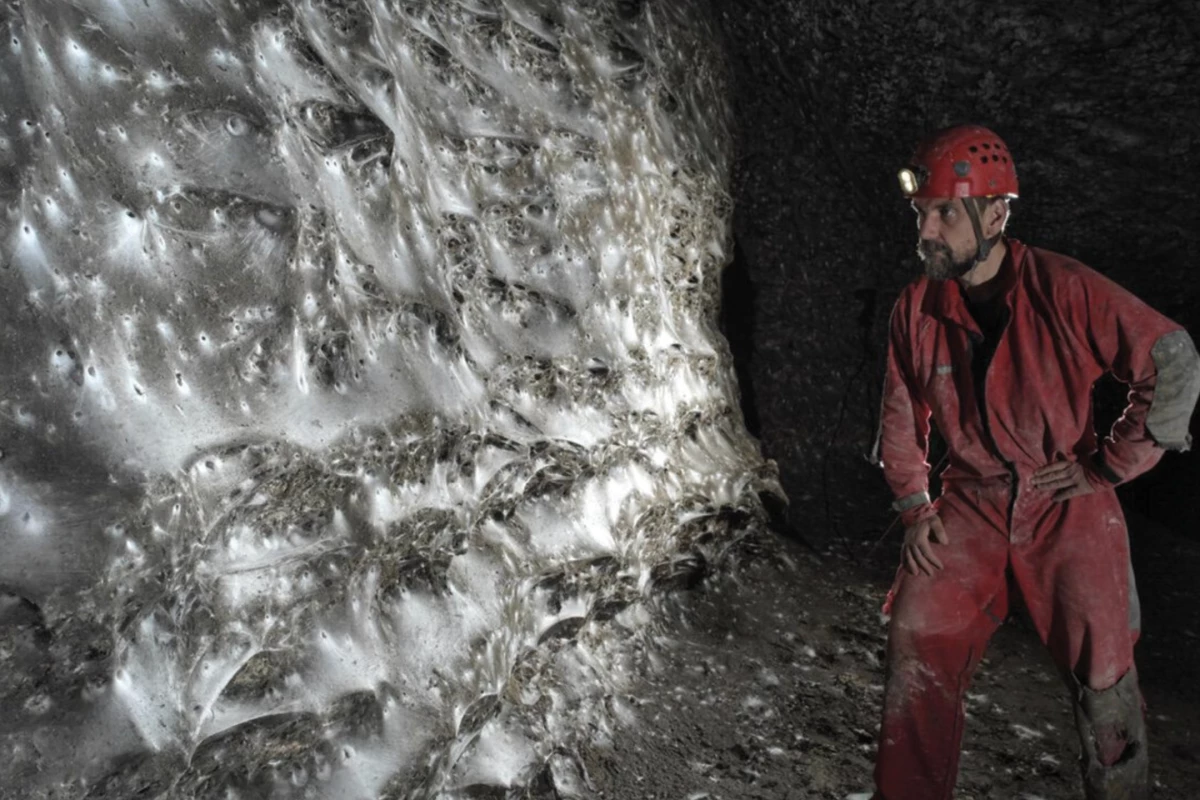Science
Scientists Discover Massive Spider Colony in Albanian Cave

Deep beneath the surface, an astonishing discovery has emerged from Sulfur Cave, located on the border between Albania and Greece. Scientists have identified a colossal communal spider web that spans over 100 square meters (approximately 1,000 square feet) and is home to an estimated 110,000 spiders. This unique find has significant implications for our understanding of spider behavior and ecosystem dynamics.
An international team of researchers, including members from the Czech Speleological Society, stumbled upon this intricate web during a wildlife survey conducted in 2022. The web is not only massive but also serves as a habitat for around 69,000 Tegenaria domestica, commonly known as the common house spider, and 42,000 Prinerigone vagans, a smaller sheet-web builder. This marks the first recorded instance of these two species cohabiting in a single web structure, indicating a remarkable example of colonial web-building in a chemoautotrophic environment.
Unique Ecosystem Dynamics
Sulfur Cave’s ecosystem is particularly fascinating. Unlike typical ecosystems that rely on sunlight for energy, this cave’s life forms thrive through chemosynthesis, converting chemical energy into organic matter. The cave is populated with sulfur-oxidizing bacteria that form thick white biofilms on wet rock and sediment. These bacteria are consumed by small invertebrates, such as midge larvae and isopods, which in turn become prey for larger insects, including the resident spiders.
The cave’s environment is sustained by a warm, toxic stream that maintains a constant temperature of around 26 °C (79 °F) and is rich in dissolved hydrogen sulfide, contributing to the area’s distinctive rotten-egg odor. Although this environment may not appeal to many, it represents a significant area of research within entomology.
Researchers noted a surprising absence of the typical cannibalistic behavior usually exhibited by T. domestica. In this habitat, thousands of these spiders coexist peacefully, creating a multilayered web across the cave’s walls. The high density of midges, approximately 45,000 per square meter (about 4,180 per square foot), provides a plentiful food source, effectively eliminating competition for resources.
Evolutionary Insights
The analysis of the spider population revealed unique genetic traits not found in their surface-dwelling counterparts. This suggests that the spiders have been evolving in isolation within the cave’s ecosystem. Furthermore, genetic testing indicated that the spiders’ carbon and nitrogen signatures trace back to sulfur-oxidizing microbes, rather than plants that rely on photosynthesis.
Remarkably, the T. domestica spiders in Sulfur Cave produce significantly fewer eggs compared to those found above ground. Researchers attribute this to the high-energy demands of living in a dark, low-oxygen environment, as well as a lack of predators that typically drive higher reproductive rates in other habitats.
“Our findings unveil a unique case of facultative coloniality in this cosmopolitan spider, likely driven by resource abundance in a chemoautotrophic cave,” the researchers concluded. This insight sheds light on the adaptability and ecological integration of surface species in subterranean environments.
The study was published in the journal Subterranean Biology, highlighting the importance of understanding how life can flourish in extreme conditions. While Sulfur Cave may seem inhospitable to human visitors, it offers a compelling glimpse into the resilience and adaptability of life in challenging environments. The research not only contributes to our knowledge of spider behavior but also emphasizes the intricate balance of ecosystems that can thrive even in the absence of sunlight.
-

 Top Stories2 weeks ago
Top Stories2 weeks agoMarc Buoniconti’s Legacy: 40 Years Later, Lives Transformed
-

 Sports3 weeks ago
Sports3 weeks agoSteve Kerr Supports Jonathan Kuminga After Ejection in Preseason Game
-

 Entertainment3 weeks ago
Entertainment3 weeks agoZoe Saldana Advocates for James Cameron’s Avatar Documentary
-

 Business3 weeks ago
Business3 weeks agoTyler Technologies Set to Reveal Q3 2025 Earnings on October 22
-

 Politics3 weeks ago
Politics3 weeks agoDallin H. Oaks Assumes Leadership of Latter-day Saints Church
-

 Science3 weeks ago
Science3 weeks agoChicago’s Viral ‘Rat Hole’ Likely Created by Squirrel, Study Reveals
-

 Lifestyle3 weeks ago
Lifestyle3 weeks agoKelsea Ballerini Launches ‘Burn the Baggage’ Candle with Ranger Station
-

 Lifestyle3 weeks ago
Lifestyle3 weeks agoDua Lipa Celebrates Passing GCSE Spanish During World Tour
-

 Health3 weeks ago
Health3 weeks agoCommunity Unites for Seventh Annual Mental Health Awareness Walk
-

 Sports3 weeks ago
Sports3 weeks agoPatriots Dominate Picks as Raiders Fall in Season Opener
-

 Health3 weeks ago
Health3 weeks agoRichard Feldman Urges Ban on Menthol in Cigarettes and Vapes
-

 Business3 weeks ago
Business3 weeks agoMLB Qualifying Offer Jumps to $22.02 Million for 2024









